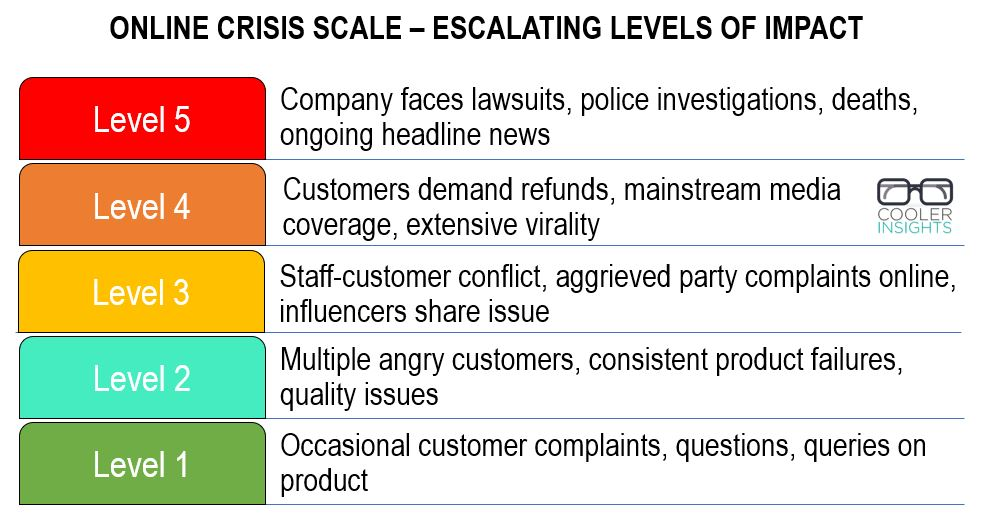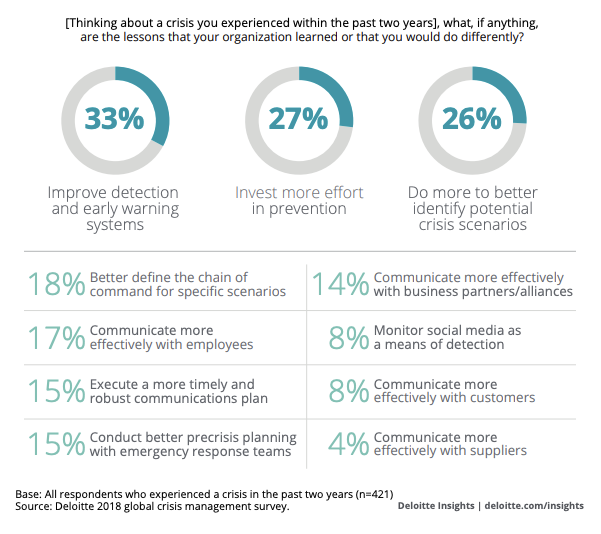After a crisis, what do you do? Respond right? However, the way you choose to respond matters too. That’s what crisis communication is all about.
In today’s fast-paced digital landscape, effective crisis communication is crucial. A well-structured plan can be a lifesaver for your business, ensuring you effectively handle and avoid further reputational damage.
This article will explore what a crisis communication plan entails, how you can integrate email and SMS into your crisis communication strategies, and how you can leverage the Vision6 platform to do so, with real-life examples.
What is crisis communication?
Crisis communication is the strategic practice of conveying information to customers and key stakeholders during emergencies. This is crucial for protecting your business’ reputation, ensuring public safety, and minimising damage.
In the digital age, the importance of crisis communication cannot be overstated. Studies have shown that 75% of companies have invested in crisis communication tools and technologies.
A poorly handled crisis response can lead to significant financial losses and damage your organisation’s reputation. For example, a major social media platform experienced a data breach in 2018, leading to a 7% drop in stock value within two days due to a lack of transparency and timely communication.
How do you create a crisis communication plan?
Good crisis response communication starts with solid planning. A well-structured crisis communication is a blueprint that specifies the actions that people will take in the event of a crisis.
You can create an effective plan by using these steps:
1. Defining a crisis
Not every unexpected event is a crisis. Clearly defining what counts as a crisis and how severe it is will help you set clear goals for management and communication. Otherwise, people may ask, ‘Is this a valid crisis?’

2. Risk assessment and preparation
Identifying potential risks is the foundation of any good crisis communication plan. This involves determining how likely a crisis, such as a natural disaster or data breach, is to occur and the impact it may have.
“You can’t prevent a crisis, but you can prepare for one.”
For example, if you’re a part of a banking institution, your crisis team should thoroughly check for possible issues like cyber-attacks or service problems. You can then minimise their impact by proactively setting up automated communication channels with customers, security teams, and other stakeholders.
3. Assign roles to the crisis management team
Define and delegate roles and responsibilities within your teams to ensure effective crisis resolution. No one person should be in charge of everything. A well-structured team can make all the difference in managing and resolving a crisis. Delegate tasks based on experience and expertise.
4. Create a communication strategy
Depending on the crisis, communication methods may vary, from simple SMS alerts to more complex plans involving social media, PR, and more.
Using reliable communication systems like SMS and email is essential for quick and easy messaging.
5. Keep communication consistent and transparent
Crisis communication relies on trust and transparency. Keep your messaging consistent across all channels, and be open with your stakeholders. Misleading information may worsen the crisis, lead to distrust, and damage your organisation’s reputation.
In a Deloitte survey, 17% of businesses said they needed better communication with employees, 8% with customers, and 15% stressed the importance of a timely and robust communication plan.

6. Address stakeholder concerns
During a crisis, stakeholders (your customers, employees, and partners) will have concerns. Considering their investments in your organisation, you should address their questions and provide timely updates.
You can learn more about using emails to make your internal communication more effective here.
7. Post-crisis evaluation
Crisis management and communication are continuous learning processes. Evaluate your communication plan after a crisis to see what worked and could be improved. This will help you refine your strategy to ensure you are prepared in case of future issues.
8. Update the crisis communications plan
Anything that is not updated is outdated. Updating your communication plans should not be restricted to just post-crisis scenarios.
Regularly adapt your crisis communication plan to changing industry scenarios and emerging threats. You can do this by studying case studies of crisis management in similar organisations or by simulating your plan in response to recent crisis events in other businesses.
How to integrate email and SMS in crisis communications
How SMS helps in crisis response
SMS is a powerful tool in crisis communication. In a world where mobile phones are ever-present, they stand out as the fastest and most direct way to reach people, especially when time is of the essence. SMS messages don’t rely on internet connectivity and work across all network providers, making it a reliable way to connect with your customers and stakeholders regardless of location.
In situations like natural disasters or public health crises, government bodies can leverage transactional SMS API services, like those offered by the Vision6 platform, for urgent communication.
During the Covid-19 pandemic, SMS messages were the primary channel for public health notices and alerts. Numerous banks also adopted SMS-based service requests and notifications to better serve customers.
For more information about the Vision6 platform’s transactional email and SMS services, click here.
Role of email in crisis response
Email can be essential to your crisis communication strategy, complementing SMS alerts. Use email to follow up with more in-depth information, share incident reports, and offer updates. Emails help convey complex messages that may exceed the character limit of an SMS.
While SMS alerts are ideal for quick and concise information relay, emails can provide more detailed content, including graphics and call-to-actions. After the initial crisis response, emails are the best channel for communication for the following reasons:
- Bulk personalisation: Emails can be sent in bulk while maintaining a personalised touch.
- Tracking and monitoring: Emails can be tracked and monitored to ensure they are delivered properly.
- Reliable source of information: Emails are a more reliable source of information since senders can be easily verified.
Click here to learn more about using email for crisis communication.
Tips for writing effective crisis communication
Now that you know pretty much everything about crisis communication, here are a few essential tips to level up your crisis comms game:
Be clear and concise: Use SMS effectively, as one credit is limited to 160 characters. Get straight to the problem and lay out all the facts.
Stay calm and empathetic: Show empathy and provide reassurance in your messages to ease the concerns of your audience.
Use simple language: Avoid jargon or technical terms. Ensure your messages are easy for everyone to understand.
Provide actionable information: Offer guidance on what steps the audience should take in response to the crisis.
Offer regular updates: Give your stakeholders timely updates on the situation and your response efforts.
Crisis communication examples using SMS
Let’s explore some real-life examples of crisis communication using SMS:
1. Service outage
Scenario: A company experiences a sudden service outage, affecting its customers. The company quickly sends out an SMS alert to inform customers about the issue, apologies for the inconvenience, and provides an estimated resolution time. This proactive communication helps manage customer expectations and reduce frustration.
SMS Alert: “We’re experiencing a service outage for our broadband services. Our team is actively working on resolving the issue. We believe the interruption is due to a fibre optics breakage, and technical experts are working tirelessly to restore service as quickly as possible.”
2. Product recalls
Scenario: SMS alerts can be a lifesaver when a product recall is necessary. Companies can immediately notify affected customers about the recall, provide instructions on returning the product, and assure them that their safety is a top priority.
SMS Alert: “Important Safety Alert: We have initiated a product recall for our S3 model scooters. Please return the vehicle to your nearest service centre for a full refund or replacement. Your safety is our priority.”
3. Appointment alerts
Scenario: Healthcare providers often use SMS to remind patients of upcoming appointments. In times of crisis, such as a pandemic, SMS is a vital tool for rescheduling, cancelling, or updating appointments as necessary.
SMS Alert: “Hello John, this is a reminder of your appointment at Lakeshore Hospital on 29 Dec 2023 at 15:00. If you need to reschedule or have any questions, please contact us at contact@example.com.”
4. Weather warnings
Scenario: Weather-related crises, like hurricanes or severe storms, require swift communication to keep people safe. Local authorities send SMS alerts to residents, warning them about impending dangers and providing guidance on how to stay safe.
SMS Alert: “Emergency Alert from National Weather Service: TORNADO WARNING in this area until 10:15 AM CST. Take shelter now in a basement or an interior room on the lowest floor of a sturdy building. If you are outdoors, in a mobile home, or a vehicle, move to the closest substantial shelter and protect yourself from flying debris. Check the media for more info.”
5. Data breaches
Scenario: In the event of a data breach, companies should promptly notify affected individuals via SMS. This proactive approach helps build trust by demonstrating transparency and a commitment to addressing the issue.
SMS Alert: “We recently identified and shut down a security event involving some of your account information. Your financial information and SSN were not affected. Go to example.com for more details.”
6. Internal crisis
Scenario: For internal crises like employee strikes or security breaches, SMS can be used to communicate with staff, providing guidance and instructions to ensure safety and order within the organisation.
SMS Alert: “Dear Team, we’re currently facing an issue with our payroll system, and as a result, salary disbursements will be delayed. We’re taking necessary actions to resolve the situation. Please reach out to the finance team for any urgent requests.”
7. Imminent threat
Scenario: In situations where an imminent threat, such as an active shooter or building fire, poses a danger to a community or workplace, SMS alerts can quickly notify people to take immediate action to protect themselves.
SMS Alert: “ATTENTION ALL EMPLOYEES: There is a fire in the East Wing of the building. Please proceed to the evacuation area between Lots A and B. Do not use the elevators now and exit the building through staircases only.”
Final takeaway:
Crisis communication is a fundamental aspect of modern business, and preparing for the unexpected is imperative. Businesses can navigate crises with transparency, empathy, and efficiency by creating a well-structured crisis communication plan, integrating email and SMS effectively, and learning from real-life examples.
In an era of digital communication, having the right tools and strategies in place can make all the difference in safeguarding your reputation and ensuring the safety and satisfaction of your stakeholders.
The Vision6 platform can help you carry out your crisis communication plan without room for error. The Vision6 platform’s transactional APIs can easily integrate with your existing systems and work seamlessly. Our extensive developer API collection allows you to trigger emails and SMS alerts in crises without any delays. Explore now!






